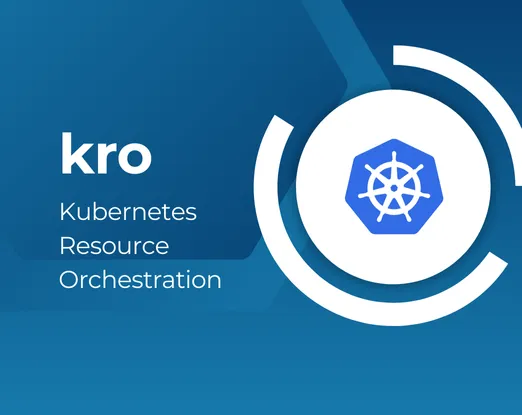The shift toward microservices architecture fundamentally changed how developers build and deploy applications. As monoliths gave way to distributed systems, organizations needed a way to reliably deploy, scale, and manage containerized workloads. Kubernetes emerged as the answer—providing a powerful orchestration platform that automated container management while offering portability across environments. This revolutionary technology quickly became the de facto standard for cloud-native development, enabling teams to handle increasing application complexity while maintaining operational resilience.
In the complex ecosystem of Kubernetes, managing multiple interdependent resources quickly becomes a challenging endeavour. As applications scale, the intricate web of deployments, services, and dependencies often leads to configuration drift, troubleshooting headaches, and operational inefficiencies that can significantly impact development velocity.
Enter KRO (Kubernetes Resource Orchestrator) – a powerful solution designed to tame this complexity through intelligent resource management. By implementing a structured, declarative approach to Kubernetes orchestration, KRO enables teams to standardize configurations, simplify deployment workflows, and automate previously manual processes across your entire container ecosystem.
The impact is immediate: DevOps teams and platform engineers can redirect countless hours previously spent on tedious configuration management toward strategic initiatives that drive innovation and scalability. With KRO handling the orchestration heavy lifting, your organization can accelerate delivery pipelines, enforce governance at scale, and maintain consistency across even the most complex Kubernetes environments.
Whether you’re struggling with multi-cluster deployments or seeking to implement GitOps best practices, KRO provides the orchestration foundation that modern cloud-native applications demand.
What is Kube Resource Orchestrator (kro)?
Kube Resource Orchestrator (Kro) is an open-source, Kubernetes-native project that simplifies managing Kubernetes resources by allowing teams to define, package, and deploy associated resources as a single, reusable entity. Kro extends the limits of Kubernetes by introducing structured blueprints that impose best practices, improve maintainability, and simplify multi-resource deployments.
Key Features of kro
1.ResourceGraphDefinition :
The core of kro is the ResourceGraphDefinition, also known as ResourceGroup. It is a template for organizing and managing a group of Kubernetes objects and their dependencies. Rather than manually working with several Custom Resource Definitions (CRDs), kro enables teams to define everything in one, well-organized resource. This makes operations more efficient and reduces complexity, enabling more effective resource management
2.Common Expression Language (CEL)
Kro uses the Common Expression Language (CEL), which is the same logic language Kubernetes admission webhooks operate on, to make resource dependencies automatic and value passing between objects automatic. Through CEL, developers can author execution orders and dependencies dynamically. This attribute adds flexibility and management control over resource orchestration.
3. Simple Schema
kro offers a simple and human-readable means of defining a new CRD spec. Behind the scenes, kro relies on the Simple Schema definition to generate the OpenAPIv3 schema automatically and produce the Kubernetes CRD. This is an improvement because Simple Schema is much simpler to read and write than OpenAPIv3 schemas
How Does kro Work
Defining ResourceGraphDefinitions
Platform engineers and compliance teams define ResourceGraphDefinitions (RGs) to group related Kubernetes resources into a single, reusable unit. Each RG acts as a structured API that standardizes how multiple resources such as deployments, services, ingress, and IAM roles should be created and managed together.
When kro is installed in a Kubernetes cluster, it registers ResourceGraphDefinition as a Custom Resource Definition (CRD). This allows platform teams to define new APIs that encapsulate best practices, security policies, and infrastructure automation.
Using an RG to Deploy Resources
Developers don’t need to manually define or manage individual Kubernetes objects. Instead, they use instance.yaml files to request resource deployments based on existing RGs. By submitting an instance.yaml, developers trigger the automated creation of all required resources while ensuring compliance with predefined configurations.
For example, applying an instance.yaml for an Application RG could automatically provision:
- A Deployment for application workloads
- A Service to expose the application within the cluster
- An Ingress for external access

Integration with Kubernetes Controllers
Since kro operates entirely within Kubernetes, it does not interact with external APIs directly. Instead, it leverages existing Kubernetes controllers to provision and manage infrastructure components. For example,
If cloud resources are needed, the cluster must include controllers like AWS Controllers for Kubernetes (ACK), GCP’s Kubernetes Config Connector (KCC), or Azure Service Operator (ASO). kro integrates with these tools to define and manage cloud dependencies
Benefits of Using kro
Unified Resource Management
Kro allows platform teams to bundle applications and their cloud resource dependencies into one deployable unit. These guarantees resources are provisioned in the right sequence and governed across their lifecycle, infusing best practices without sacrificing central governance.
Enabling Seamless Collaboration
With kro, the Platform, Compliance, and Security teams are able to define APIs that normalize settings, making it simple for developers to use secure and compliant practices. This method embeds security and compliance into deployments without adding extra complexity to developers.
Ensuring Standardized Deployments
Consolidated APIs enable best practices to be defined, enforced, and automated across environments so applications are secure, compliant, and running. A standardized deployment framework minimizes errors, eliminates configuration drift, and improves reliability.
Streamlining Infrastructure Management
Data platform engineers can put all the essential pieces into kro RGDs. This includes cloud resources, networking, storage, and Kubernetes objects. This makes deployment easier, so developers can execute application without having to think about infrastructure.
